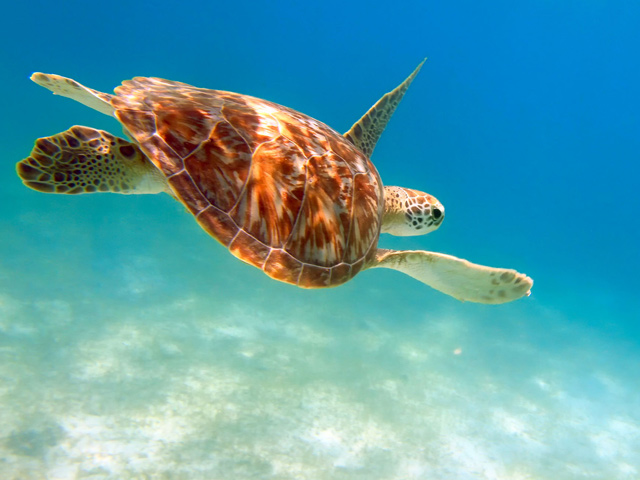
Sea turtles spend most of their lives in the ocean, only returning to land to dig into beach sand to lay their eggs, after which they immediately head back out to the ocean. Photo © ishtygashev/123rf.
The Atlantic coast is popular for sea turtles to make their nests, and Florida is a particularly favored place. There are some 70,000 sea turtle nests made annually along the Florida coastline, and most of them are made by loggerhead turtles. If lights along the shore disorient them, [baby sea turtles] can go the wrong direction and wind up trying to cross a highway instead of diving into the sea.Sea turtles spend most of their lives in the ocean, only returning to land to dig into beach sand to lay their eggs, after which they immediately head back out to the ocean. This is a doubly dangerous proposition for the creatures. First, the sea turtles return to the same spot every year to make their nests, guided by the currents, stars, and most importantly, the light of the moon; development along the Atlantic shoreline has obviously resulted in a lot more light along the beach, which both disorients and imperils the turtles. Second, those nests are often dug in the very same beaches where crowds of sun-worshippers descend daily, which occasionally results in the nests being crushed. Even if the mama turtle makes her way to the right spot and the nest remains undisturbed long enough for the turtles to hatch, the baby turtles still aren’t out of the woods, as they have to rely on the same combination of moonlight and stars to make their way back to the ocean. If lights along the shore disorient them, they can go the wrong direction and wind up trying to cross a highway instead of diving into the sea.Obviously, coastal development has gone hand in hand with a steep decline in the sea turtle population. Thankfully there are now numerous regulations barring humans from interfering with nests or turtles, as well as a number of common sense reminders around the beach area to minimize light pollution during the summer nesting months. Groups like the Fort Lauderdale-based National Save the Sea Turtle Foundation (877/887-8533) are doing a great job raising awareness of the turtles’ struggles and educating tourists and locals about what they can do to keep from being part of the problem.
You can even support their mission by adopting a sea turtle nest. The Museum of Discovery and Science (401 SW 2nd St., 954/467-6637) also hosts moonlight sea turtle walks in May, June, and July.
Excerpted from the First Edition of Moon Florida Road Trip.